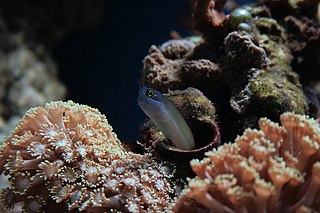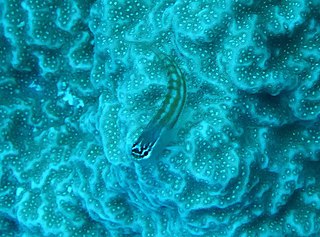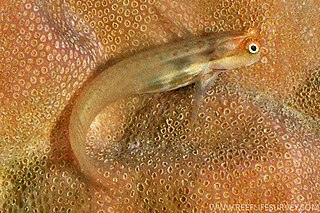Ecsenius fourmanoiri, the blackstriped combtooth blenny, is a species of combtooth blenny in the genus Ecsenius. It is found in the western Pacific ocean. It can reach a maximum length of 4.9 centimetres. Blennies in this species feed primarily off of benthic algae and weeds. The specific name honours the French ichthyologist Pierre Fourmanoir (1924-2007), who collected the first specimens of this species and realised that it had not been described.
Ecsenius isos is a species of combtooth blenny in the genus Ecsenius. It is found in coral reefs in the western central Pacific ocean, around New Hebrides and New Caledonia. It can reach a maximum length of 3.2 centimetres. Blennies in this species primarily feed off of plants, including benthic algae and weeds.> The specific name isos refers to the dark spots beneath the blennies' heads.

Ecsenius melarchus, known commonly as the yellow-eyed comb-tooth or the Java combtooth-blenny in Indonesia, is a species of combtooth blenny in the genus Ecsenius. It is found in coral reefs in the western Pacific ocean. It can reach a maximum length of 5 centimetres. Blennies in this species primarily feed off of plants, including benthic algae and weeds, and are commercial aquarium fish. The specific name "melarchus" is Latin for "black anus", and refers to the black anal marking on the blennies in this species.

Ecsenius schroederi, known commonly as the Schroeder's combtooth-blenny in Indonesia, is a species of combtooth blenny in the genus Ecsenius. It is found in coral reefs in the western Pacific ocean, specifically in Indonesia. It can reach a maximum length of 7 centimetres. Blennies in this species feed primarily off of plants, including benthic algae and weeds, and are commercial aquarium fish. The species was named in honour of the wildlife artist and scientific illustrator Jack R. Schroeder (1954-2004).
Ecsenius lividanalis, known commonly as the blue-head combtooth-blenny in Indonesia and also known as the blue-headed combtooth blenny, is a species of combtooth blenny in the genus Ecsenius. It is found in coral reefs throughout the western Pacific ocean. It can reach a maximum length of 5 centimetres. Blennies in this species feed primarily off of plants, including benthic algae and weeds, and are commercial aquarium fish. There are two colour forms of this blenny, both of which have a black spot around the anus. One form has a blue head with a yellow body and iris while the other form is dark, occasionally all yellow, with a bluish-white iris, a yellow back and a yellow caudal fin.

Ecsenius mandibularis, also known as the many-toothed blenny, Queensland combtooth blenny or Queensland blenny in Australia, is a species of combtooth blenny in the genus Ecsenius. It is found in coral reefs in the western Pacific ocean, including the southern edge of the Great Barrier Reef. It can reach a maximum length of 7.5 centimetres. Blennies in this species feed primarily off of plants, including benthic algae and weeds.
Ecsenius oculatus, the ocular coralblenny, is a species of combtooth blenny in the genus Ecsenius. It is found in coral reefs in the western Indian ocean. It can reach a maximum length of 4.7 centimetres. Blennies in this species feed primarily off of plants, including benthic algae and weeds.
Ecsenius oculus, known commonly in Micronesia as the ocular blenny and as the coral blenny on Christmas Island, is a species of combtooth blenny in the genus Ecsenius. It is found in coral reefs in the western Pacific ocean. It can reach a maximum length of 7 centimetres. Blennies in this species feed primarily off of plants, including benthic algae and weeds, and are commercial aquarium fish.
Ecsenius tricolor, known commonly as the Derawan combtooth-blenny in Indonesia, is a species of combtooth blenny in the genus Ecsenius. It is found in the western central Pacific ocean, around the Philippines and Borneo. It can reach a maximum length of 6 centimetres. Blennies in this species feed primarily off of plants, including benthic algae and weeds.

Ecsenius opsifrontalis, known commonly as the comical blenny in Micronesia, is a species of combtooth blenny in the genus Ecsenius. It is found in coral reefs in the Pacific Ocean. It can reach a maximum length of 5 centimetres. Blennies in this species feed primarily off of plants, including benthic algae and weeds, and are commercial aquarium fish.
Ecsenius pardus is a species of combtooth blenny in the genus Ecsenius. It is found in the western Pacific ocean, around Fiji. It can reach a maximum length of 4.8 centimetres. Blennies in this species feed primarily off of plants, including benthic algae and weeds.
Ecsenius paroculus, the spottedback coralblenny, is a species of combtooth blenny in the genus Ecsenius. It is found in coral reefs in the western Pacific ocean. It can reach a maximum length of 4 centimetres. Blennies in this species feed primarily off of plants, including benthic algae and weeds.
Ecsenius portenoyi is a species of combtooth blenny in the genus Ecsenius. It is found in the western central Pacific ocean. It can reach a maximum length of 4.5 centimetres. Blennies in this species feed primarily off of plants, including benthic algae and weeds. Its specific name honours Norman S. Portenoy of Bethesda, Maryland for his support of the ichthyological expeditions of the National Museum of Natural History.
Ecsenius randalli is a species of combtooth blenny in the genus Ecsenius. It is found the western central Pacific ocean, around Indonesia. It can reach a maximum length of 2 centimetres. Blennies in this species feed primarily off of plants, including benthic algae and weeds. The specific name of this blenny honours the American ichthyologist John E. Randall of the Bishop Museum in Honolulu, who collected the type, photographed it and permitted Victor G. Springer to describe it.
Ecsenius sellifer, known commonly as the saddle blenny in Guam, or the saddle clown blenny in Micronesia, is a species of combtooth blenny in the genus Ecsenius. It is found in coral reefs in the western Pacific ocean. It can reach a maximum length of 4.1 centimetres. Blennies in this species feed primarily off of plants, including benthic algae and weeds.

Ecsenius stictus, known commonly as the Great Barrier Reef blenny, is a species of combtooth blenny in the genus Ecsenius. It is found in the Great Barrier Reef, and around the Chesterfield Islands. It can reach a maximum length of 5.8 centimetres. Blennies in this species feed primarily off of plants, including benthic algae and weeds.
Ecsenius tessera is a species of combtooth blenny in the genus Ecsenius. It is found in coral reefs in the western Pacific ocean, around Vanuatu. It can reach a maximum length of 4.5 centimetres. Blennies in this species feed primarily off of plants, including benthic algae and weeds.
Ecsenius tigris, known commonly as the tiger blenny in Australia, is a species of combtooth blenny in the genus Ecsenius. It is found in the western Pacific ocean, specifically the western Coral Sea. It can reach a maximum length of 5 centimetres. Blennies in this species feed primarily off of plants, including benthic algae and weeds, and are commercial aquarium fish.

Ecsenius trilineatus, known commonly as the three-lined blenny in Australia, and the white-spotted comb-tooth or the white-spotted combtooth blenny in Indonesia, is a species of combtooth blenny in the genus Ecsenius. It is a non-migoratory species of blenny found in coral reefs in the western central Pacific ocean. It can reach a maximum length of 3 centimetres. Blennies in this species feed primarily off of plants, including benthic algae and weeds, and are commercial aquarium fish, but of no interest in fisheries.

Ecsenius yaeyamaensis, known commonly as the Yaeyama blenny in Guam and Micronesia, and also known as the Yaeyama clown blenny in Micronesia, or the Pale-spotted combtooth-blenny in Indonesia is a species of combtooth blenny in the genus Ecsenius. It is found in coral reefs in the western Pacific and Indian oceans. It can reach a maximum length of 6 centimetres. Blennies in this species feed primarily off of plants, including benthic algae and weeds, and are commercial aquarium fish.







